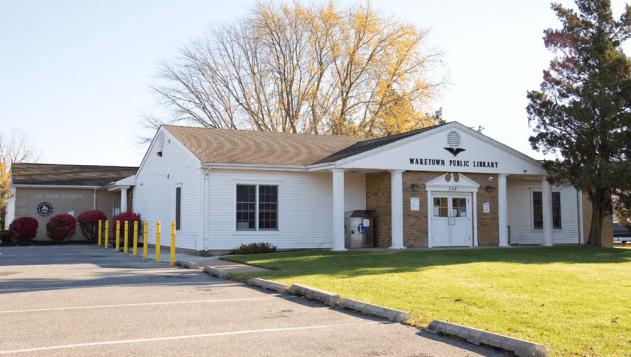The Township of Ocean was incorporated on April 13, 1876. At that time, the major village, situated on what is now Route 9, was Waretown. Approximately seven miles to the west lay the village of Millville, which became Brookville in 1892, when the post office was established. Since that post office no longer exists and there is no municipal government in Brookville, Waretown and the Township of Ocean are now one and the same.
At one time, Pancoast Road brought the Lenni-Lenape Indians to the Bay every summer to fish and hunt. The first vessel on record as having sailed in Barnegat Bay was an American built sailboat entitled the Onrest. “It was a Dutch ship and the name meant restless. Its function was to map the bay, its streams, channels and other points of interest to make way for future colonists. Before long the bay was full of white sails so that some of our first settlers came here by boat, while others filtered down by land using old Indian trails. Waretown was originally called Waier Creek or Waier Mills in 1762, after Abraham Waier, who had come to the area with a religious sect known as the Rogerines. Expelled from Connecticut for their hostility to the Puritan laws of New England, the Rogerines arrived here in 1739.They moved on eleven years later, but Waier stayed and built a mill.
Children in Ocean Township attended the Little Red School House from the mid 1800s until 1958, which is when the Waretown Elementary School opened its doors. The Little Red School House was originally located on the current site of the Waretown First Aid Squad. With increased enrollment, an addition was added to the Waretown Elementary School in 1965.
As Waretown grew, it became evident that either another addition or new school was needed. A referendum was scheduled and the new school passed by one vote, 631 to 630! In September of 1974, the Waretown Elementary School went on split sessions, K-6, until the Ocean Township Elementary School was completed in 1978. At that time, kindergarten and third grade classes were moved to the Ocean Township Elementary School while the Waretown Elementary School was for first and second grades only.
In 1984, Chief School Administrator, Frederic A. Priff, passed away and soon the name of the Ocean Township Elementary School was renamed the Frederic A. Priff Elementary School in his honor. In 1993, additions to both schools were built. This enabled kindergarten and third grade students to be back at the Waretown Elementary School. The total district enrollment for Waretown’s elementary students is 519.
“The first recorded religious society to settle in Waretown was the ROGERINES who came here in 1737. This peculiar sect, founded by John Rogers in Connecticut, came to New Jersey because of its tolerance to religious beliefs and customs,” (Beattie and Lopez unpaged). The Methodist Society formed in Waretown about the time of the Revolutionary War and the Waretown United Methodist Church was completed being built in 1968. Waretown’s St. Stephen’s Episcopal Church’s mission began in 1923 and has grown into a church at 367 Route 9.
From 1700 to 1900, Waretown was quite the shipbuilding center. “The place was Waretown Creek, which harbor was larger than of today, it lay between Skipper’s Cove, of today, and Pennsylvania Avenue on the south the estuary was known as Shipyard Point,” (Beattie and Lopez unpaged). This gave employment to lumbermen because someone had to cut oak, cedar, and other woods for the ships. “As steamboats became more popular, the delivery of cordwood, cheaply, was needed and Waretown became an extremely busy place. Carpenters, shipbuilders, fitters, ironworkers, blacksmiths, caulkers, sail makers, and all specialists in the art of shipbuilding were needed. In the 1830s, competition between the steamboats was very keen, it was found that cordwood was taking too much space on deck, especially on long voyages it displaced cargo. The demand for charcoal, in the absence of coal, grew in popularity,” (Beattie and Lopez unpaged) and the men of Waretown were trained on how to make charcoal. From 1920 to 1940, there was a good market for oysters and Waretown had plenty. From 1930 to 1950, clamming became very popular and prosperous. After the fifties, the scallops came back into the bay which also proved to be quite prosperous. Cranberrying was a booming industry in Waretown around the 1900s. Cranberrying started in Waretown in 1916 by Arthur and Stogton Corliss. Arthur and Stogton Carliss also owned a successful mossing business, The American Moss and Peat Co., Corliss Brothers Proprietors. “Spagnum moss was usually ordered in the early spring by florists and asparagus and strawberry growers and the like,” (Beattie and Lopez unpaged).
Waretown’s railroad was established in 1870 and was a necessity not only for the transportation of people and mail, but for the quick shipment of seafood to North Jersey and New York.
Perhaps because of the unique nature of many of its early industries, there is a strong sense of community among Waretown's older families. However, in the last 25 years the town has become a significant retirement area, and while many of these retirees have now been here for decades, they do not identify with the town in the same way as the families who have been here for generations. Their loyalties are more to the developments they live in (Skippers Cove, Pebble Beach, etc.) than to the Township of Ocean as a whole.
Most residents who have moved into the township since World War II came from either northern New Jersey (especially Bergen and Hudson counties and the Newark area), or from Greater Philadelphia, but some have also relocated from New York City, Bucks County, Pennsylvania, and the Trenton area.
According to the 2000 Census, population of the township is 6,450. Of that total, 4,807 residents were over the age of 18, while 1,743 were under 18.



